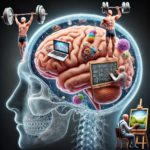💊Cognitive Load
Cognitive load refers to the amount of mental effort being used in working memory at a particular point in time. This is crucial because not all information being processed in working memory ends up being stored in long term memory. Traditionally, cognitive load it is divided into three types:
- Intrinsic Load – This is the inherent complexity of the information or task itself. For example, understanding complex medical concepts involves a naturally high intrinsic load. The more complex the subject, the more effort your brain must exert to process and store the information.
- Extraneous Load – Caused by how information is presented, rather than the task itself. For example, unclear or disorganized instructions increase extraneous load, making it harder to focus on the core learning material. In medical studies, poorly designed learning materials add unnecessary strain on the brain’s ability to retain core concepts.
- Germane Load – This is the mental effort used to integrate new information with what you already know. This involves building upon your foundational knowledge and linking it with existing knowledge or previous experience, solidifying long-term learning. For example, .
Physiology – Cognitive Load
Cognitive load primarily affects the prefrontal cortex. The brain region responsible for complex thought, decision-making, and problem-solving. When cognitive load is too high, the prefrontal cortex becomes overwhelmed, leading to reduced working memory capacity and impaired learning efficiency. Neuroimaging studies, such as fMRI scans, show that excessive cognitive load can result in neural overload, where regions of the brain become less efficient at processing information, affecting overall cognitive performance.
Research indicates that managing cognitive load is crucial for effective learning, especially in fields requiring high mental demand. Techniques such as chunking information (breaking complex data into smaller, digestible pieces) and using dual coding theory (combining verbal explanations with visual aids) have been shown to reduce cognitive strain and improve learning outcomes.
🤔Why You Need to Know
When you know the answer to the question: why do we remember some things but not others? You can apply those principles to learn faster and more effectively. Understanding this concept will help you simplify ideas, optimize learning, retain memories, and increase productivity. In addition, recognizing when your cognitive load is too high allows you to make adjustments, ensuring you focus on what truly matters. By managing these parameters, you can improve your ability to process complex information, stay organized, and avoid mental fatigue, especially during busy times in professional settings.
📝Action Items:
Limit Extraneous Load in Study Materials:
A study published in Educational Psychology Review found that simplifying and organizing information can reduce extraneous load, improving comprehension and retention (Sweller et al., 2011). When creating notes or presentations, aim to minimize distractions and ensure clarity in structure.
Practice Spaced Repetition:
Research from Harvard University shows that spaced repetition, or reviewing material at increasing intervals, optimizes cognitive load. This allows for better long-term retention and integration of new information with existing knowledge (Karpicke & Roediger, 2008).
Use Visual Aids for Complex Concepts:
A study published in Applied Cognitive Psychology demonstrated that using visual aids like diagrams and flowcharts can enhance understanding by reducing intrinsic load (Clark & Mayer, 2016). For medical students, integrating anatomical images with text can significantly improve learning outcomes.
Break Tasks into Smaller Segments:
Chunking information has been shown to reduce cognitive load and improve recall. A study from Cognitive Science found that learners who chunked their study material into smaller sections had a 30% increase in retention compared to those who studied in larger blocks (Miller, 1956).
🤯Trivia – Cognitive Load
NASA uses cognitive load management techniques to help astronauts perform complex tasks in space. By breaking instructions into small, step-by-step guides, astronauts can reduce mental strain and avoid errors during high-stakes missions.



